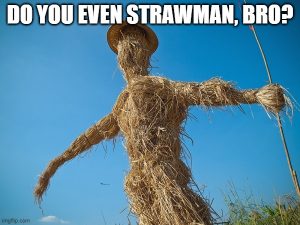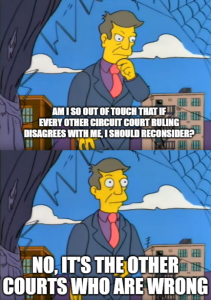Bonkers Opinion Repeals Section 230 In the Third Circuit–Anderson v. TikTok
 This decision is bonkers. The majority implies that any effort to curate third-party content automatically converts the third-party content into first-party content so that it no longer qualifies for Section 230 immunity. Because every UGC service necessarily curates every content item (by promoting the content; and even if they don’t do that, the services all use their TOS standards as curation tools), the majority’s legal standard would categorically negate Section 230 in the Third Circuit. As Mike Masnick says, “this ruling takes a wrecking ball to 230. It basically upends the entire law.” It’s a terrible example of judicial activism.
This decision is bonkers. The majority implies that any effort to curate third-party content automatically converts the third-party content into first-party content so that it no longer qualifies for Section 230 immunity. Because every UGC service necessarily curates every content item (by promoting the content; and even if they don’t do that, the services all use their TOS standards as curation tools), the majority’s legal standard would categorically negate Section 230 in the Third Circuit. As Mike Masnick says, “this ruling takes a wrecking ball to 230. It basically upends the entire law.” It’s a terrible example of judicial activism.
The concurrence/dissent, written by a TAFS judge, is also terrible. Powered by cites to non-credible sources (e.g., 7 cites to Justice Thomas non-precedential statements and 8 cites to Candeub), the judge takes the position that Section 230 applies only to hosting, not to any other aspect of the publication process.
This opinion urgently needs en banc review. (Whether that happens or not, this case eventually will be appealed to the Supreme Court, and the express conflict with other circuits makes it a good cert candidate). Unless the 3rd Circuit en banc quickly and decisively rejects this opinion, it will be celebrated by other judges eager to blow up Section 230 (of which there are many). As a result, I expect this opinion provides another hard shove towards the impending and seemingly inevitable end of Section 230–and the Internet as we know it.
* * *
Background
As is often the case with Section 230 cases, this case involves a tragedy. A ten-year-old watched a “Blackout Challenge” video recommended in her TikTok “for you” page, tried to emulate the challenge, and hanged herself. Heartbreaking. The mom sued TikTok, alleging “TikTok: (1) was aware of the Blackout Challenge; (2) allowed users to post videos of themselves participating in the Blackout Challenge; and (3) recommended and promoted Blackout Challenge videos to minors’ FYPs through its algorithm, including at least one such video to Nylah’s FYP, which resulted in her death.” TikTok defended on Section 230 grounds, and the district court agreed with TikTok.
[Note: as the Wiki entry indicates, the Blackout Challenge predates TikTok and the Internet.]
[Note: I’m sad for the victims, and I don’t intend any disrespect towards them in the post. However, justice is not served when the wrong entities are held liable.]
The Majority Opinion
The Third Circuit reverses the district court. The majority states its position clearly:
Given the Supreme Court’s observations [in Moody] that platforms engage in protected first-party speech under the First Amendment when they curate compilations of others’ content via their expressive algorithms, it follows that doing so amounts to first-party speech under § 230, too. [cite to Justice Thomas’ non-precedential musings in Doe v. Snap.]
I’ll try to translate. The majority doesn’t enumerate the universe of content curation algorithms that are “expressive,” but I would take the position that all “algorithms” are by definition expressive. Even reverse chronological order is an editorial choice about the best way to present content to the service’s audience. The majority says that if the First Amendment protects algorithms–which it does–and a service uses algorithms to “curate” third-party content–which it must–then the service qualifies for First Amendment protection but not Section 230 protection because there is no longer any “third-party content.” Ergo, Section 230 never will work in the Third Circuit.
 The majority expressly recognizes that it’s collapsing the first-party/third-party distinction, saying “We recognize that TikTok’s first-party speech captures certain third-party speech.” This is an odd sentence. For example, I have no idea what “capture” means here. Despite the third-party content that’s been “captured,” the majority cites Moody as saying that “exercising editorial discretion in the selection and presentation of content qualifies as speech activity whether the content comes from third parties or it does not” [cleaned up]. Because the publisher gets First Amendment protection for “speaking” third-party content, the majority says it automatically must accept all liability for publishing that content. That completely inverts Section 230’s raison d’etre.
The majority expressly recognizes that it’s collapsing the first-party/third-party distinction, saying “We recognize that TikTok’s first-party speech captures certain third-party speech.” This is an odd sentence. For example, I have no idea what “capture” means here. Despite the third-party content that’s been “captured,” the majority cites Moody as saying that “exercising editorial discretion in the selection and presentation of content qualifies as speech activity whether the content comes from third parties or it does not” [cleaned up]. Because the publisher gets First Amendment protection for “speaking” third-party content, the majority says it automatically must accept all liability for publishing that content. That completely inverts Section 230’s raison d’etre.
So, riddle me this: if qualifying for the First Amendment simultaneously means that the service automatically disqualifies for Section 230, then why did Congress enact Section 230 at all? 😵 See my piece on the First Amendment/230 interplay, though it never contemplated a result as bonkers as this one.
The majority’s reliance on Moody for its content-character-changing conclusion is especially baffling because the Supreme Court Moody majority opinion had nothing to do with Section 230 or its statutory interpretation. The Moody majority opinion never mentions Section 230 once, and I doubt the majority justices thought they were somehow talking about Section 230. The Moody majority opinion was also emphatically pro-free speech, and this panel turns that on its head to reach an anti-speech conclusion. I would love to hear Justice Kagan’s private thoughts reading this opinion.
Invoking Justice Thomas’ Doe v. Snap statement exacerbates the majority’s logic problems. In that case, the perpetrator and victim direct-messaged each other. Presumably, the majority would say that the conversations aren’t mediated by an algorithm (I would debate that), but Justice Thomas thinks that facilitating that conversation doesn’t qualify for Section 230. Putting the two positions together: use an algorithm, Third Circuit says no 230. Don’t use an algorithm, Thomas says no 230. 🤔
 I want to make sure you don’t miss the point, so I will reiterate the precedent the majority uses to bolster its conclusion. The majority relies on two primary sources: (1) a Supreme Court opinion that doesn’t once reference the statute this panel is interpreting, and (2) a non-precedential dissent from denial of certiorari written by a justice who wasn’t in the majority on the opinion in #1. That’s really some top-notch legal analysis there. 💯
I want to make sure you don’t miss the point, so I will reiterate the precedent the majority uses to bolster its conclusion. The majority relies on two primary sources: (1) a Supreme Court opinion that doesn’t once reference the statute this panel is interpreting, and (2) a non-precedential dissent from denial of certiorari written by a justice who wasn’t in the majority on the opinion in #1. That’s really some top-notch legal analysis there. 💯
I guess some kudos ought to go out to the plaintiffs’ lawyers. They clearly won the narrative battle and made a difficult doctrinal sale. Hundreds of other plaintiffs’ lawyers have tried and failed to make the same sale. Sometimes it doesn’t matter if you’re lucky or good.
* * *
It’s an easy application of the majority’s legal standard to TikTok’s case: “because the information that forms the basis of Anderson’s lawsuit—i.e., TikTok’s recommendations via its FYP algorithm—is TikTok’s own expressive activity, § 230 does not bar Anderson’s claims.”
* * *
In FN12, the majority backpedals. It says “We reach this conclusion specifically because TikTok’s promotion of a Blackout Challenge video on Nylah’s FYP was not contingent upon any specific user input. Had Nylah viewed a Blackout Challenge video through TikTok’s search function, rather than through her FYP, then TikTok may be viewed more like a repository of third-party content than an affirmative promoter of such content. Given the type of algorithm alleged here, we need not address whether § 230 immunizes any information that may be communicated by the results of a user’s search of a platform’s content.”
Princess Leia again….
Search results are the outputs of expressive algorithms, protected by the First Amendment, to curate third-party content–exactly what the majority said would turn the outputs into first-party content that don’t qualify for Section 230. The majority doesn’t address the First Amendment protection for search algorithms because that would undercut everything it said earlier. Instead, the majority hypothesizes algorithmic search results might be different because “specific user input” make search results “more like a repository of third-party content than an affirmative promoter of such content.” This is nonsense. The majority doesn’t define the term “specific user inputs,” nor does it have an obvious meaning. For example, does “following” a third party’s account mean that the resulting videos shown in algorithmic feed are “specific user inputs” or not? 🤷♂️ Plus, the “for you” page is curated based on the users’ specific activities, which sound like “specific user inputs” to me. And the majority never established that the First Amendment or Moody treats content promotion and content “repositories” (what are those?) any differently, so it hasn’t proven its baseline. The majority has no way of credibly distinguishing search results from the “for you” page while relying on Moody, and that makes it impossible to determine what the majority actually thinks Section 230 still covers in the Third Circuit.
There’s also the problem that decades of Section 230 jurisprudence conflict with the majority’s standard. In a mondo FN13 (over a page long), the majority expressly acknowledges:
- “this holding may be in tension with Green v. America Online (AOL)” from the Third Circuit. Other Third Section 230 cases that the majority ignores completely: DiMeo v. Max, Obodo v. Magedson, Parker v. Google, Hepp v. Facebook, Oberdorf v. Amazon, and Kabbaj v. Google. (Some of these are non-precedential opinions).
- “our holding may depart from the pre-NetChoice views of other circuits” (citing rulings from the 1st, 2nd, 5th, 6th, 8th, 9th, and DC Circuits)
Yes, the majority doesn’t care about the conflicts. Per the majority, all of that precedent instantly became bad law on July 1, 2024 because Moody changed EVERYTHING about Section 230 jurisprudence. In other words, this majority thinks the Supreme Court sub silento overturned hundreds of cases and decades of precedent across the country with respect to a statute it never actually discussed. Quite a ruling from the Supreme Court.
In sum, this panel majority felt comfortable (1) overruling longstanding circuit precedent; (2) expressly conflicting with at least 7 other circuits; and (3) ruling without doing oral arguments post-Moody and therefore possibly not having complete briefing. These are all excellent reasons to take this case en banc.
The Concurrence/Dissent
Often, when a panel majority goes off the rails, the third judge will bring some much-needed sanity and validate the readers’ concerns about the bad opinion. Not here. Judge Matey’s concurrence/dissent is perhaps even MORE bonkers than the majority. Talk about a bad panel draw.
Judge Matey’s position: Section 230 applies exclusively to content hosting; everything else is outside its scope. This is more favorable to defendants if the majority’s “expressive curation = 1st party content” nukes Section 230 for content hosting; but it’s less favorable to defendants if the majority (per FN12) doesn’t mean what it said, while Judge Matey’s standard would eviscerate Section 230 and shrink the Internet into Dropbox and Google Drive links.
Judge Matey’s opinion is typical MAGAlicious junk. (If you’re citing Matt Stoller, you need to rethink your information diet). I have already spent too much of my life debunking MAGAlicious opinions, so I’m not going to do it again. Instead, I’ll just critique a few of its worst aspects.
__
In the intro paragraph, the opinion says that Section 230 “has become popular among a host of purveyors of pornography, self-mutilation, and exploitation, one that smuggles constitutional conceptions of a “free trade in ideas” into a digital “cauldron of illicit loves” that leap and boil with no oversight, no accountability, no remedy.” Great to see the judge start off with a balanced and well-informed view about the Internet’s strengths and weaknesses.
__
“TikTok knew that Nylah would watch because the company’s customized algorithm placed the videos on her “For You Page” after it “determined that the Blackout Challenge was ‘tailored’ and ‘likely to be of interest’ to Nylah.”” The judge accepted the plaintiffs’ allegations as true, but what does the Taamneh opinion say about TikTok’s “knowledge” here?
__
“It is conventional wisdom that § 230 was passed to, at least in part, overrule Stratton Oakmont.” That’s not just conventional wisdom. Per Section 230’s legislative history: “One of the specific purposes of this section is to overrule Stratton-Oakmont v. Prodigy.”
__
“Today, § 230 rides in to rescue corporations from virtually any claim loosely related to content posted by a third party, no matter the cause of action and whatever the provider’s actions.” Seriously? This sentence is fiction. Section 230 has four statutory exceptions and an ever-growing list of common law exceptions. The cause of action matters to Section 230. The provider’s actions matter to Section 230. Section 230 doesn’t have a “loose” connection to third-party content–that’s one of the three prima facie elements of a successful defense. So much strawman.
Also, Section 230 doesn’t just “ride in” to “rescue corporations.” (I’m recycling the GIF I just used with the YOLO case, which also used an automotive metaphor to denigrate Section 230). Section 230 provides legal certainty to publishers to enable users to talk with each other. The companies are a beneficiary of Section 230, but so are all of us.
__
 “The result is a § 230 that immunizes platforms from the consequences of their own conduct and permits platforms to ignore the ordinary obligation that most businesses have to take reasonable steps to prevent their services from causing devastating harm.” Another strawman. Section 230 doesn’t insulate defendants from their own conduct; that’s literally the opposite of what it does. However, it’s true that Section 230 is an exceptionalist statute. That’s why it’s so important and effective.
“The result is a § 230 that immunizes platforms from the consequences of their own conduct and permits platforms to ignore the ordinary obligation that most businesses have to take reasonable steps to prevent their services from causing devastating harm.” Another strawman. Section 230 doesn’t insulate defendants from their own conduct; that’s literally the opposite of what it does. However, it’s true that Section 230 is an exceptionalist statute. That’s why it’s so important and effective.
__
“Section 230 was passed to address an old problem arising in a then-unique context, not to “create a lawless no-man’s-land” of legal liability.” SIGH.
__
Judge Matey adopts the now-standard MAGA argument that Section 230 preempted publisher liability, not distributor liability. However, Section 230 expressly refers to both “publisher” and “speaker” liability, and the “speaker” reference undermines word parsing of “publisher” liability if you’re a textualist. In FN18, Judge Matey responds: “The reference to “speaker” in § 230(c)(1) does not change the meaning of the text.” Hmm–a textualist believes the statute contains superfluous words? He continues: “When § 230 was enacted, courts often referred to traditional publisher liability as treating the disseminator of a statement as the “original speaker” subject to the same strict liability. See Jonathan A. Friedman & Francis M. Buono, Limiting Tort Liability for Online Third-party Content Under Section 230 of the Communications Act, 52 Fed. Comm. L.J. 647, 650 (2000). Consistent with common law tort theory, I refer to such claims as publisher liability rather than “third” versus “first-party speech.” Doing so also avoids the confusing commingling of statutory and constitutional language that can conflate the distinct legal meanings of “speech.”” In other words, the word “speaker” is really inconvenient to his preferred theory, so how about if we just don’t talk about it?
Also, for critics claiming Zeran was wrongly decided–a reminder that Congress expressly endorsed Zeran in 2002 in the Dot Kids Implementation and Efficiency Act’s legislative history, which said: “The Committee notes that ISPs have successfully defended many lawsuits using section 230(c). The courts have correctly interpreted section 230(c), which was aimed at protecting against liability for such claims as negligence (See, e.g., Doe v. America Online, 783 So.2d 1010 (Fla. 2001)) and defamation (Ben Ezra, Weinstein, and Co. v. America Online, 206 F.3d 980 (2000); Zeran v. America Online, 129 F.3d 327 (1997)). The Committee intends these interpretations of section 230(c) to be equally applicable to those entities covered by H.R. 3833.
__
FN22 is a page long footnote distinguishing the Third Circuit’s Green opinion. Judge Matey says it is 2 decades old and “decided very little,” including (according to the judge) nothing about the publisher/distributor distinction. So like the majority, he feels free to ignore it.
__
Judge Matey’s conclusion laments the “the dreary state of the modern internet. The marketplace of ideas, such as it now is, may reward TikTok’s pursuit of profit above all other values. The company may decide to curate the content it serves up to children to emphasize the lowest virtues, the basest tastes. It may decline to use a common good to advance the common good.” I’d love to hear more about the times when media enterprises didn’t place profits over other values. Maybe he should use a time-machine to travel back to those good ol’ days. (I hear the theme from All in the Family playing in my head).
Case Citation: Anderson v. TikTok, Inc., 2024 WL 3948248 (3d Cir. Aug. 27, 2024)



